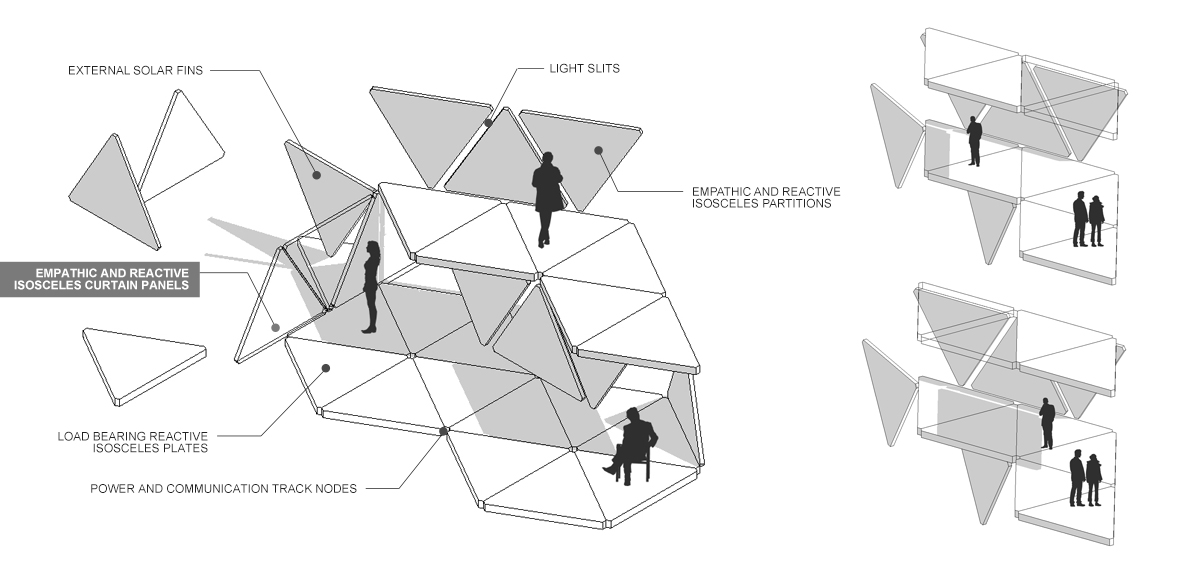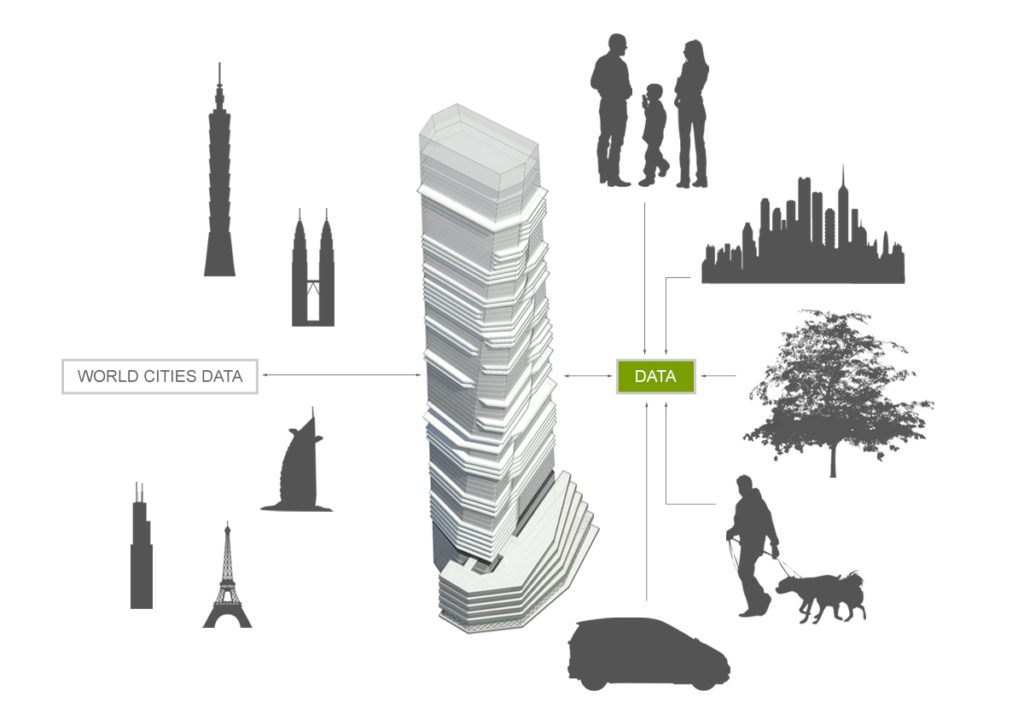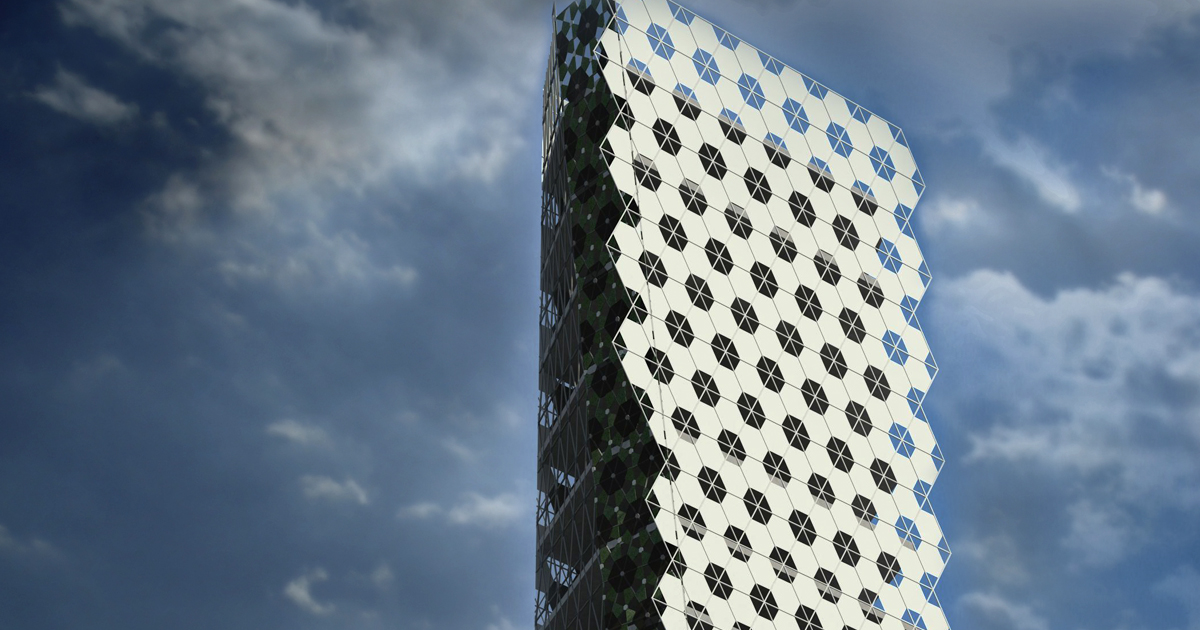Thought I’d share a studio project back in 2011 which revolves around the idea of creating empathic panels to be used as surface materials. The word empathic here loosely describes the ability to sense and react to some kind of stimuli whether environmental or biological. I imagine that there would be these panels that can be developed to gather, centralize, and analyze data as well as provide a parametric feedback mechanism that actually changes the form of the panel in order to adapt to its directives. It would seem like we would no longer live inside inanimate structures but interact with active appliances that envelope and protect our welfare. Maybe the concept is no longer that fresh now but back then when I was still tinkering with this concept, there were only a handful of resources then. Most of which merely focus on mechanical control systems. Thymotecture is about adding some sort of technological spirit to buildings. I’m talking about baselines, monitoring and evaluating real-time performances, forms that actually validate themselves, and best of all, operates like the internet where all panels anywhere in the world are connected and can share data and applications. I have an ongoing paper on this actually but thought it is better to occasionally upload portions of the study for discussions.
An Introduction To Thymotecture
Green buildings and sustainable designs are major movements in the design, development, and construction industry today. Climate responsive designs are becoming an integral part of the environmental framework practices all around the world. With the advent of the communications and information era, the building industry has even started adopting fresh technologies and techniques that would enhance collaborations on virtual building environment modeling in order to address issues on sustainability, resource management, energy analysis, and construction responsibilities. Architects and allied professionals in the industry are working together in the hope of reducing the impact on the environment and human health.
Are Policies Enough?
Diversified policies are being introduced as well to help establish standards in measuring new construction. A green building that adheres to proposed design and construction practices that significantly reduce or eliminate the negative impact of building on the environment and occupants are being classified under rating systems and certifications. A point-based rating system is a consolidated approach to estimations of particular credits to best practices in various disciplines of architecture, engineering, interior design, landscape architecture, and construction.
Given the complexity involved in solving barriers to a more sensitive and responsible future building construction and operations, how do we further determine if a development used with proposed design and construction practices did significantly reduce or eliminate the negative impact of buildings on the environment and occupants? More so, how do we evaluate or monitor an entire collection of buildings’ relationships to one another and the urban ecosystem in which they support in accordance with an ideal global environmental setting? How do we bridge this gap between technology in the early design stages to the final product delivery?
We need a system that could deliver the more intrinsic prognosis of our planet’s ailments in places where human intervention is at its most alarming density. We can only take steps toward administering the corresponding cure if we could only deploy feedback mechanisms to know exactly what we are up against.
The future of climate-responsive buildings is the formation of techno-organic surfaces capable of intelligent sensory, communication, and reactive systems.

Thymotecture is an accumulation of spirited technologies enabling developments in architecture for empathic skyscrapers of tomorrow, capable of monitoring and measuring anthropogenic and environmental interferences using techno-organic surface appliances as building materials. Similar to the introduction of steel as a breakthrough material to height barriers, computational technology at the birth of social industrialization attract the use of techno-organic building innovations and techniques that would promote a new movement in architecture.
Thymotecture Begins At Surface Sensing
Building surface elements could be compacted with computational processors and graced with input/output interfaces. These elements such as partitions, finishes, openings, or envelopes in turn are connected by a global network that would have the ability to gather data and respond to applications much similar to portable devices with internet capabilities. Building parts can then start to act as appliances communicating with other building parts in as much as one whole building interacting with its surrounding site or even with an entire city. Hence, the intention is to induce spiritedness in architecture as with Arthur Koestler’s The Ghost in the Machine.
This network of building part appliances becomes a building broadcasting system delivering empirical prognosis of the planet’s ailments in places where human intervention is at its most alarming density. By deploying feedback mechanisms and knowing exactly what we are up against, we can then take corresponding steps toward the more sensible climate-responsive design solutions.

The Role Of Multi-Sensors In New Building Designs
Multi-sensor fusion and integration is a rapidly evolving research area in today’s multi-disciplinary fields of artificial intelligence and robotics, weapon systems, biomedical systems, signal processing, remote sensing, and transportation networks. Empirical computations from multi-sensors may be able to advance current tools in Building Information Modeling to Meta-Point Cloud Modeling with real-time prototyping, simulation, security, and feedback analysis in a complete cycle of design.
Sensors, Controls, and Actuators
As an act of representation, whether virtual or live, built-in actuators could also orchestrate as a whole to invoke the entire surface skin to perform morphological responses based on parametric computations gathered from both nearby and remote techno-organic datasets hence fostering new forms, new types of curves or shapes, or possibly elicit unimaginable surface configurations on its own. Meanwhile, an open-source trade of techno-organic innovations may be able to transform the manufacturing industry into a more socially motivated platform.
The Building’s Artificial Intelligence In Thymotecture
A formalized vernacular expression that would freshly engulf the concrete and glass landscape with techno-organic building materials sprouting from Thymotecture’s basic principle of sensing the truth around us and mankind’s monitored reaction to it. Hopefully, the relationship of interdependence we develop with these sensing surface appliances creates a positive attachment and involvement for the much more climate-informed future communities to evolve into.
